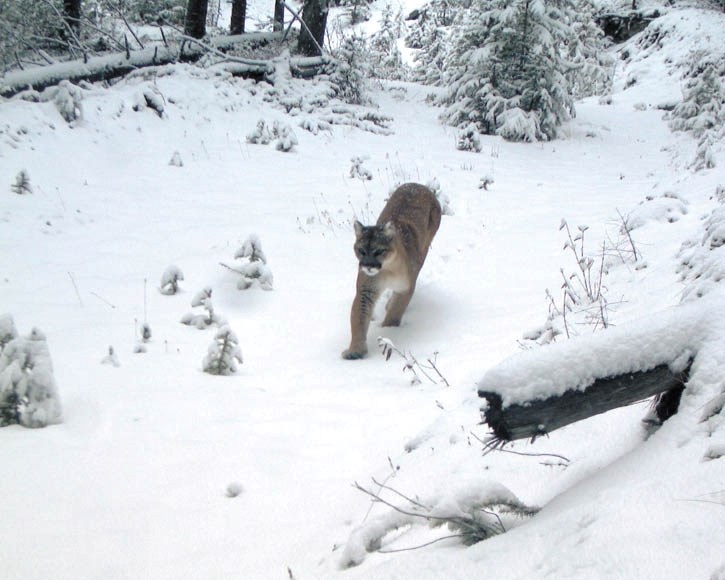A wildlife corridor study of the eastern portion of the Bow Valley has revealed pinch points for animals in the area of provincial campground operations and industry.
The Eastern Bow Valley Wildlife Corridor Study was released in November and provincial parks ecologist Melanie Percy said while corridor research has been ongoing around Canmore since the mid-1990s, the eastern parts of the valley have not had the same attention paid to them.
“We have quality information about wildlife corridors and habitat use patterns around Canmore, but very little east of Canmore,” Percy said. “Maintaining wildlife connectivity and habitat connectivity is a high priority for parks.
“A lot of wildlife in parks and protected areas use this area to navigate.”
In 2004, however, Lafarge partnered with the World Wildlife Fund with a priority of defining corridors and habitat patches in the eastern parts of the valley.
Funding from the conservation partnership allowed Alberta Parks to undertake the study released last fall.
“The underlying objective of the study was to identify wildlife movement corridors and critical habitat areas for wildlife in the east Bow Valley,” Percy said. “Once we have an idea, we can use that information to better inform land management decisions to maintain those movement corridors.”
Lafarge’s manager of community relations Joel Taguchi said the science-based assessment of where animals are is important for the company’s operations, future expansion and reclamation plans.
“What the report provided us with is a scientific summary of the species of animals and their travel patterns,” he said. “The plant is located at a natural pinch point in the valley which makes the science crucial to our long-term planning.
“Right now we are in a stage of redevelopment for the long-term viability and sustainability of the plant and, as we develop a sense of what the footprint options of the plant are going to look like in 50 years, we are most certainly factoring in the science from the study.”
All quarries that operate in the province are required to have a reclamation plan. Development of that plan will use data collected on wildlife movement needs and sensitivities.
Taguchi said Lafarge already considers wildlife with respect to where and how it fences its operations.
“We need to make sure we take a balanced approach in our pursuit of safety and security of the lease and balance that with the needs of wildlife,” he said. “We will continue to work with the science and engineers for a quarry that allows us to operate the way we need to operate and at the same time responds to the needs of wildlife in that part of the valley.”
Taguchi said one of the strengths of the report is the tracking data was collected over a six-year period, allowing trends and patterns to be identified.
The Bow Valley and wildlife movement within it is not just locally important, it is regionally significant, said Percy. Large carnivores especially use huge areas to travel between sub-populations.
“We were able to identify areas we would consider critical to preserve wildlife movement in the area,” she said.
In particular, Three Sisters Campground in Dead Man’s Flats sits right in the middle of a bottleneck for wildlife movement.
With the highway fencing, Bow River and wildlife crossings immediately east and west of the hamlet, movement of animals, said Percy, is funneled through the campground and as a result officials are looking for alternative locations to put it.
“We need to relocate the campground because we do not have any options for expanding the corridor,” she said.
The McGillvray slabs climbing area is another pinch point for movement because of the cliffs, highway and lake nearby.
Percy said land managers will not want to see any additional development in that area as a result.
Unknown before the study was how important the Quaite Valley is for lynx.
What the study ultimately reveals is something already intuitively known – that wildlife in the eastern portion of the valley are contending with natural and human-induced habitat fragmentation.
“Secure movement opportunities are very limited,” Percy said.
The corridor study uses a systematic design with transects set out in areas expected to be pinch points to minimize the amount of survey work and maximize track detection.
Each transect is a survey line that is walked in through fresh snowfalls to observe evidence of wildlife with intervals every 50 metres.
Once a track is detected it is then backtracked through the snow to ensure humans and wildlife did not come into conflict.
Because the study is conducted in winter, grizzly and black bears were not counted. Percy said all species of felids were detected – bobcat, lynx and cougar – as well as wolverines.
No wolves were tracked, but data from a prior wolf tracking study was incorporated into the results.
“Because we want to look at how wolves potentially use the study area we incorporated data from the central Rockies wolf project,” Percy said.
While the study provides valuable information on movement, Percy said it does not provide information on temporal movement patters – when animals are using corridors.
That information will require further research and the use of radio telemetry, collars or cameras.
The study reinforced the science contained in other corridor studies, including that animals prefer shallow slopes.
“Slopes and elevation seem to drive movement patterns,” Percy said, adding cougars prefer slopes less than 30 degrees and other species less than 25 degrees. “The data in this study is consistent with the BCEAG guidelines for corridor use.
“That is a positive thing and further strengthens the case of maintaining corridors on lower slopes.”




